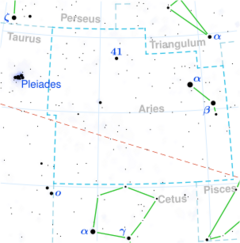Astronomy:Iota Arietis
| Observation data Equinox J2000.0]] (ICRS) | |
|---|---|
| Constellation | Aries |
| Right ascension | 01h 57m 21.05476s[1] |
| Declination | +17° 49′ 03.1202″[1] |
| Apparent magnitude (V) | 5.117[2] |
| Characteristics | |
| Spectral type | K1p[3] or G8III[4] |
| U−B color index | +0.700[2] |
| B−V color index | +0.921[2] |
| Astrometry | |
| Radial velocity (Rv) | −4.9[5] km/s |
| Proper motion (μ) | RA: +34.76[1] mas/yr Dec.: −22.95[1] mas/yr |
| Parallax (π) | 6.27 ± 0.33[1] mas |
| Distance | 520 ± 30 ly (159 ± 8 pc) |
| Absolute magnitude (MV) | −0.4[6] |
| Orbit[7] | |
| Period (P) | 1,567.66±0.62 d |
| Semi-major axis (a) | ≥ 217 Gm (1.45 astronomical unit|AU) |
| Eccentricity (e) | 0.356±0.022 |
| Periastron epoch (T) | 2,420,961.1±27.2 JD |
| Argument of periastron (ω) (secondary) | 94.04±4.72° |
| Semi-amplitude (K1) (primary) | 10.78±0.31 km/s |
| Details | |
| Mass | 3.17[8] M☉ |
| Radius | 20[8] R☉ |
| Luminosity | 240[8] L☉ |
| Surface gravity (log g) | 2.60[9] cgs |
| Temperature | 5,031[8] K |
| Metallicity [Fe/H] | −0.10[9] dex |
| Rotational velocity (v sin i) | 3.33[9] km/s |
| Other designations | |
| Database references | |
| SIMBAD | data |
Iota Arietis, Latinized from ι Arietis, is the Bayer designation for a binary star system in the northern constellation of Aries. It has an apparent visual magnitude of 5.117;[2] bright enough to be dimly seen with the naked eye. Parallax measurements made during the Hipparcos mission yield an estimated distance of 520 light-years (160 parsecs) from Earth.[1] The variable radial velocity of this system was announced by W. W. Campbell in 1922. K. C. Gordon published orbital elements for this single-lined spectroscopic binary system in 1946, giving an orbital period of 4.29 years and an eccentricity (ovalness) of 0.36.[7]
For the visible component, in 1952 N. G. Roman found a stellar classification of K1p, where the 'p' indicates some type of peculiarity with the spectrum. Her comments indicated that the "Hydrogen lines and λ 4290 are strong enough to indicate a class II star, but the CN is barely strong enough for class III, and the Sr II is not much stronger than this would require.".[3] E. A. Harlan published a class of K peculiar in 1969, commenting, "Hδ strong, Fe I λ4045 is weak for type".[11] In 1990, K. Sato and S. Kuji gave a class of G8III, suggesting this is an aging G-type giant star and questioning its peculiar status.[4] Bayesian inference of the stellar properties indicates this star is on the horizontal branch.[8] The companion is a suspected white dwarf.[12]
References
- ↑ 1.0 1.1 1.2 1.3 1.4 1.5 van Leeuwen, F. (November 2007), "Validation of the new Hipparcos reduction", Astronomy and Astrophysics 474 (2): 653–664, doi:10.1051/0004-6361:20078357, Bibcode: 2007A&A...474..653V.
- ↑ 2.0 2.1 2.2 2.3 Jennens, P. A.; Helfer, H. L. (September 1975), "A new photometric metal abundance and luminosity calibration for field G and K giants.", Monthly Notices of the Royal Astronomical Society 172 (3): 667–679, doi:10.1093/mnras/172.3.667, Bibcode: 1975MNRAS.172..667J.
- ↑ 3.0 3.1 Roman, Nancy G. (July 1952), "The Spectra of the Bright Stars of Types F5-K5", Astrophysical Journal 116: 122, doi:10.1086/145598, Bibcode: 1952ApJ...116..122R.
- ↑ 4.0 4.1 Sato, K.; Kuji, S. (1990), "MK classification and photometry of stars used for time and latitude observations at Mizusawa and Washington", Astronomy and Astrophysics Supplement Series 85: 1069, Bibcode: 1990A&AS...85.1069S.
- ↑ Wilson, Ralph Elmer (1953), "General Catalogue of Stellar Radial Velocities", Carnegie Institute Washington D.C. Publication (Washington: Carnegie Institution of Washington), Bibcode: 1953GCRV..C......0W.
- ↑ Helfer, H. L.; Wallerstein, George (August 1968), "Abundances in K-Giant Stars. II. a Survey of Field Stars", Astrophysical Journal Supplement 16: 1, doi:10.1086/190169, Bibcode: 1968ApJS...16....1H.
- ↑ 7.0 7.1 Gordon, Katherine C. (1946), "The Spectroscopic Orbit of ι ARIETIS", The Astrophysical Journal 103: 16–18, doi:10.1086/144784, Bibcode: 1946ApJ...103...16G, http://articles.adsabs.harvard.edu/full/1946ApJ...103...16G.
- ↑ 8.0 8.1 8.2 8.3 8.4 Stock, Stephan et al. (August 2018), "Precise radial velocities of giant stars. X. Bayesian stellar parameters and evolutionary stages for 372 giant stars from the Lick planet search", Astronomy & Astrophysics 616: 15, doi:10.1051/0004-6361/201833111, A33, Bibcode: 2018A&A...616A..33S.
- ↑ 9.0 9.1 9.2 Hekker, S.; Meléndez, J. (2007), "Precise radial velocities of giant stars. III. Spectroscopic stellar parameters", Astronomy and Astrophysics 475 (3): 1003–1009, doi:10.1051/0004-6361:20078233, Bibcode: 2007A&A...475.1003H.
- ↑ "* iot Ari". SIMBAD. Centre de données astronomiques de Strasbourg. http://simbad.u-strasbg.fr/simbad/sim-basic?Ident=%2A+iot+Ari.
- ↑ Harlan, E. A. (September 1969), "MK classifications for F- and G-type stars. I", Astronomical Journal 74: 916, doi:10.1086/110881, Bibcode: 1969AJ.....74..916H.
- ↑ Eggleton, P. P.; Tokovinin, A. A. (September 2008), "A catalogue of multiplicity among bright stellar systems", Monthly Notices of the Royal Astronomical Society 389 (2): 869–879, doi:10.1111/j.1365-2966.2008.13596.x, Bibcode: 2008MNRAS.389..869E.
External links
 |


